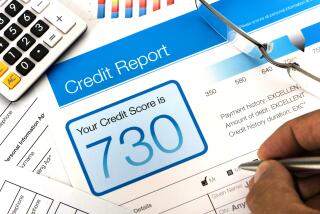Correct Your Credit Errors and You’ll Reduce Your Interest Rate
Are your credit scores high enough to qualify you for the lowest interest rate on a new home mortgage? If not, could factual errors hidden in your electronic credit files be depressing your scores artificially?
Mortgage and credit industry experts say the odds of errors are greater than you might suspect. Whereas 10 years ago loan officers routinely reviewed individual credit reports with applicants, today’s high-speed, automated underwriting environment emphasizes credit scores, with little opportunity for review of the files that produced the scores.
Match or exceed the lender’s preset credit score minimum and you get the best rates and terms. Come in below that mark, and you pay more--possibly a lot more. But new developments in the mortgage credit arena are giving consumers opportunities to check out--and correct--their credit files quickly enough to get better rate quotes from lenders. Credit-reporting firms have begun signing up mortgage lenders and brokers for online data-correction services that can push up scores in less than a week.
One of the most ambitious of these, known as Scorefacts.com, is run by the California-based firm, Standfacts Credit Services Inc. Lenders and brokers participating in the Scorefacts program instruct Standfacts to flag all loan applicants’ credit reports with scores below a designated threshold. Generally, the cutoff point separates applicants who qualify for the lender’s best rates from those who don’t.
When home-loan applicants’ scores are below the designated mark, they immediately get an e-mail saying that their credit files contain data they may wish to review. Applicants can then go to a secure, Scorefacts Web site, punch in an access code, and examine the full electronic credit files that were pulled from the three national credit bureaus--Equifax, Experian and TransUnion. If any of the negative information depressing their scores is wrong, applicants can quickly begin the process of correcting the files.
Standfacts promises lenders that most errors can be corrected within 72 hours of receipt of documentation from creditors confirming the mistaken information. Then the loan applicants can be “rescored”--usually to their benefit on rates and fees.
Gary Kassan, president of Standfacts, said he has seen scores jump more than 100 points when the incorrect information is removed, and the mortgage applicant is rescored. More typically, he said, scores increase by smaller increments--20 to 30 points--”but that’s frequently all that’s needed” to move an applicant into a lower interest-rate category.
Most lenders and brokers nationwide use FICO credit-risk scores, named after their developer, Fair, Isaac & Co. Inc. Proprietary FICO software is installed at each of the three national credit bureaus. Scores are generated when electronic credit files are ordered and run through the software. High scores--720 and above--indicate a relatively low risk of borrower default. Scores in the 600s and below are considered higher risk.
But some of the negative information in a credit file may be mistaken. For instance, an incorrect report of a nonpayment on a debt or a misfiling by a department store regarding a charge account.
One of the most common mistakes, Kassan said, is confusion over names within families. Father and son may have similar names, for instance, but father always pays his bills on time while junior is a deadbeat. The result: Some credit reports erroneously mix junior’s bad behavior with dad’s pristine credit history. When dad goes to apply for a loan, his FICO scores are too low to qualify him for the rates and terms he deserves.
How costly are those artificially depressed scores on a home mortgage? Very. According to Fair, Isaac’s latest nationwide rate survey covering thousands of lenders (posted at www.myfico.com), a consumer applying for a mortgage with a FICO score between 500 and 559 would qualify for no better than a 10.2% fixed-rate 30-year loan.
The same person with a score between 620 and 674 would be quoted 8.43%. With a score between 700 and 719, the rate would drop to 6.7%, and above 720 the borrower would get a 6.6% loan.
Could the presence of unseen bad data in your files cost you 2 or more percentage points--and potentially tens of thousands of dollars of higher monthly payments--on your home loan? Absolutely.
If your broker or lender uses a rescoring service such as Kassan’s, you may get a shot at correcting your files in time to get the rate you deserve. Ask about it at application.
Otherwise, you can do the same thing in advance: Before applying for a loan, order all three of your credit reports, contact any creditors who have entered erroneous information about you, and get it all corrected.
*
Kenneth R. Harney’s e-mail address is kenharney@aol.com. Distributed by the Washington Post Writers Group.






